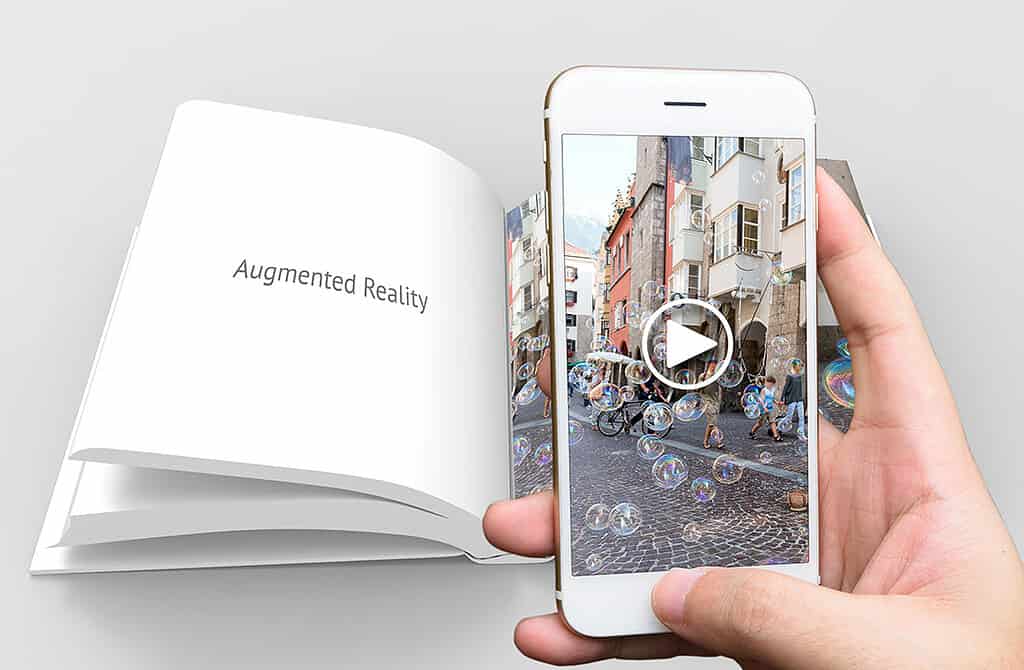Augmented reality Augmented reality (AR) is a technology that makes it possible to integrate virtual objects into the real world. In contrast to virtual reality, which immerses the user completely in a virtual environment, AR augments reality with digital information and graphics. But what exactly is augmented reality, what technologies are needed to implement AR applications and what areas of application are there?
The best-known example of AR is the Pokémon GO app, which allows players to search for and catch digital characters in their real environment. The small monsters that the player hunts are placed in the real world, which the player sees on the display through the camera of their smartphone. A few years ago, the resulting gaming experience caused a real hype, with groups of young people roaming the cities for months on end hunting virtual monsters. This example shows impressively how great the potential is when the real and digital worlds meet.
The devices
Augmented reality technology is often used by mobile devices such as smartphones or tablets. By using cameras, sensors and software, these devices can scan the user's physical environment and insert digital objects into the camera image in real time. There are also AR glasses such as the Hololens 2 The holographic display projects digital content, such as holographic objects, into the user's field of vision. By using gestures and voice commands, the user can interact with the digital objects and place them in their real environment.
Augmented reality as an app vs WebAR via the browser
AR with an app and Web AR are two ways to experience augmented reality content on mobile devices. The use of augmented reality apps requires the download and installation of a special app on the device, while web AR can be accessed via a browser.
Using AR through an app usually provides a better and more immersive augmented reality experience because the app is tailored to the specific device and its features. The app can also access the device's collected data such as GPS, camera, accelerometer, and more to create a richer AR experience.
On the other hand, Web AR has the advantage of not requiring the installation of a dedicated app, making it more accessible. Web AR can also be launched directly from a website, making it easier for marketers or developers to create and share AR content.
AR Frameworks
There are a variety of AR frameworks that help developers create and deploy AR content. The cost of AR frameworks can vary depending on the framework, licensing model, and project requirements. Some AR frameworks are free and open source, while other frameworks require licensing fees or subscription fees.
Here are some popular AR frameworks:
- ARKit: A framework from Applewhich is integrated into iOS devices and enables developers to create AR content using the device's camera, gyro sensor and accelerometer. ARKit is the free AR framework from Apple. ARKit offers features such as horizontal and vertical surface recognition, face recognition, positioning AR objects in the real world and interacting with AR objects through gestures. ARKit also provides a variety of tools and resources to help developers create AR content, including ARKit developer documentation, sample code and an active developer community.
- ARCoreA framework from Google that runs on Android devices and creates AR content using the device's camera, gyro sensor and accelerometer. ARCore is quite similar to ARKit in terms of features. However, Apple's framework delivers slightly better tracking due to the Apple devices' better sensor technology.
- VuforiaAn AR framework that runs on a variety of platforms and allows developers to create AR content using the camera and image recognition. Vuforia offers a free version with limited features and several paid versions with advanced features and support.
- Unity AR Foundation: An AR framework based on Unity Engine and enables developers to create AR content for iOS and Android devices. Unity AR Foundation is part of the Unity Engine, which offers paid licenses and subscriptions.
- WikitudeA framework that runs on a variety of platforms and allows developers to create AR content using the camera and image recognition. Wikitude offers a free version with limited features and several paid versions with advanced features and support.
WebAR Frameworks
There are also frameworks that are based on WebAR are specialized
- Google Model ViewerGoogle Model Viewer is a free web tool from Google that allows users to view 3D models in a AR or VR-environment. The tool is easy to use and supports a variety of 3D model file formats. The framework is free of charge.
- 8th WallWith 8th Wall, developers can create AR experiences in web and mobile applications that run on iOS and Android devices. The framework offers a variety of features, including hand and face recognition, spatial and environmental recognition, and integrations with other tools and platforms. Developers can also embed 3D models, images and videos into their AR experiences and program them using Javascript and HTML5. 8th Wall is technologically the most advanced WebAR framework, but also the most expensive.
- ZapWorks TheZapworks Editor Toolkit offers a variety of features, including interactive 3D models, augmented reality effects and animation tools. Developers can also create their own custom scripts and embed them into their AR experiences. ZapWorks is a powerful tool that offers users a variety of options and features. Zapworks has its own 3D engine. However, you can also use content from other WebGL Transform and embed engines like AR SDKs for Three.js, Unity, A-Frame, PlayCanvas, Babylon.js, JavaScript and React-Three.js into WebAR experiences with Zapworks.
The cost of AR frameworks
The cost of AR frameworks can also be increased by additional costs such as hosting, data processing, server access, and other infrastructure requirements. Developers should carefully consider the costs and compare the different options to find the most suitable framework for their needs. Costs vary quite a bit from framework to framework. It is also important to note that the success of an AR project depends not only on the choice of framework, but also on the quality of content, usability, and marketing strategy.
Areas of application for AR technology
The application areas of AR technology are very diverse and range from the entertainment industry to medical care. Here are some examples:
- Entertainment: AR is being used in the gaming industry to create a more immersive and interactive gaming experience. One example is the app Pokémon Go.
- Education: AR can be used to create interactive learning content that improves student understanding. One example is the anatomy app Augmented Anatomy.
- Tourism: AR can be used in the tourism industry to virtual tours and city tours that help travelers to better understand their surroundings.
- Retail: AR can be used in retail to enable virtual try-on of clothing or furniture items and provide a better shopping experience for the customer.
- Healthcare: AR is used in healthcare to help doctors diagnose and treat patients, as well as to train medical staff.
- Architecture and construction: AR can be used in architecture and construction to create 3D virtual models of buildings and give users a better idea of what the finished building will look like.
- Automotive: AR can be used in the automotive industry to create virtual cockpits and navigation systems and give drivers a better overview of the vehicle.
These are just a few examples that show how diverse the possible applications of AR technology are.









